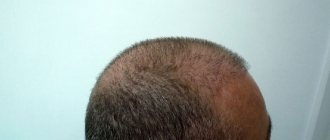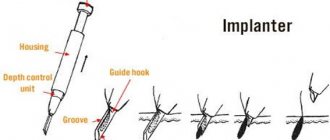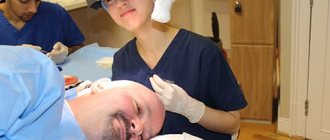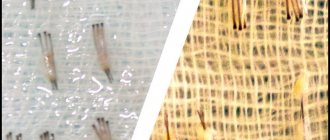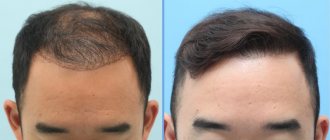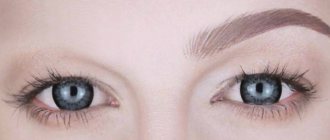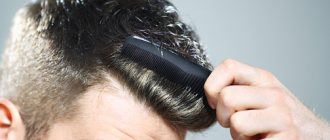Partial or complete damage to the hair on the head, beard and eyebrows occurs in both males and females, less often in children. This unpleasant disease has a scientific name - alopecia. This disease brings aesthetic suffering. Many people are embarrassed by their appearance; for others, baldness interferes with their professional activities. Cosmetic surgery for hair restoration through transplantation can help you get rid of baldness permanently.
Hair transplantation
Historical reference
The origin of modern surgical intervention and a breakthrough in the development of a method that allows the use of small pieces of skin (graft) with the roots of hair follicles for transplantation belongs to the outstanding American doctor Norman Orentreich. Back in 1952, he himself experimentally developed the basic concept of transplantation from the occipital donor areas of the head. He proved that with this method of transplantation, the hair retains its original qualities and takes root on the head for many years.
Important ! The development and improvement of transplantation continues, the latest methods of transplantation without scalpel incisions and the selection of donor materials by a small group of up to four to five follicles within one sebaceous gland in a common blood supply channel have been developed.
In Russia, transplantation began to emerge in 1996 with the opening of the first Moscow clinic specializing in hair transplantation. There are currently establishments with this profile in many regions of the country.
Back in 1952, a hair transplant technique appeared.
Who even came up with hair transplants?
Japanese surgeon Suji Okuda, a doctor in the Kwantung Army, became interested in the topic in the 1930s. In 1939, his work “Clinical and Experimental Hair Transplantation” was published. Before this, hair was not transplanted; wigs were worn.
Okuda performed more than 200 surgeries on military volunteers. Hair transplants covered scars and burns received during the war.
For hair transplantation, Okuda used a puncher. Miniature, of course - a circular metal trephine with a diameter of 4 mm. Spoiler alert: not much has changed since then.
Grafts for transplantation
Using a puncher, the surgeon drilled out grafts (pieces of skin with hair follicles) from the back of the head, and then inserted them into the right places. But things didn’t work out - politics got in the way. Japan supported Germany in World War II. After Hitler lost the war, the country found itself on the outskirts of civilization.
In the 60s, scientists began to extract one hair at a time to make the transplant result more natural. And only about 15 years ago, surgeons realized that it was more effective to transplant natural microtufts of hair.
Such bundles have a common blood supply channel and a common sebaceous gland. The process is complex and time-consuming, but the result is impressive.
Main causes of alopecia
Baldness is caused by various reasons, manifesting itself both with rapid, frightening hair loss, and with a slow, not immediately noticeable process of gradual baldness. Many causes are not fully understood, and this causes controversy in medical circles. The health of the entire organism as a whole is judged by the condition of the hair, its thickness, shine, and thickness of the hairs.
There are many causes of baldness
The main causes of baldness.
- Hormonal disorders caused by various diseases.
- Increased testosterone levels, as well as an increase in androgen levels in the blood. In women, this problem can be caused by pregnancy, lactation, or taking hormonal contraceptives.
- Heredity - as a rule, it plays a big role in the development of such a problem. Pathology is usually transmitted by genes from grandfather to father, and then to grandson, etc.
- Fungal infection of the skin - causes focal hair loss, the formation of baldness and plaques.
- Disturbances in the blood circulation of the head and brain caused by vascular diseases can cause the death of hair follicles and baldness.
One of the causes of baldness may be poor circulation. - A general decrease in immunity causes a decrease in the body’s resistance to all diseases.
- Diets, especially strict ones, lead to a reduction in the supply of nutrients and minerals to the scalp, which, of course, are of great importance for the condition of the hair.
- Severe nervous disorders, stress.
- Small capillaries sharply narrow, the flow of blood into the bulbs slows down or stops altogether, and they die.
- An unhealthy lifestyle often leads to increased hair loss. Excess nicotine and aldehydes in the blood destroys the nutrition of the scalp.
Alcohol and cigarettes cause hair loss
Causes of baldness (7 factors)
Before resorting to a scalp hair transplant procedure, it is important to find out for what reasons a man or woman began to experience baldness.
Most often, hair loss is a consequence of the following internal and external factors:
- Chronic diseases. If a chronic disease occurs in the body, this negatively affects the functioning of the immune system, leading to its weakening and dysfunction. In such cases, not only hair suffers, but also skin, nails, and teeth. Therefore, if the obvious causes of baldness are not noticeable, you need to undergo a diagnostic examination, identify the pathology and properly treat it. Sometimes after this the hairline is restored.
- Hormonal imbalances. Hormonal imbalances often cause excessive hair loss in girls during puberty, as well as in women while pregnant.
- Poor nutrition. If a person’s diet is poor and poor in healthy food containing vitamins and other vital elements, this will primarily affect the condition of the hair. Due to a lack of nutrients, hair follicles become thinner, die and are no longer restored.
- Chronic stress. During stress, blood vessels spasm, resulting in impaired blood circulation. This leads to deterioration in the nutrition of hair follicles and their gradual death.
- Severe dietary restrictions. As with poor nutrition, strict diets cause a deficiency of vitamins and other nutrients in the body. Having decided to get rid of extra pounds, you should not resort to such methods, because they often cause serious damage to the entire body.
- Mistakes when leaving. In women, hair falls out when drying and curling tools are used incorrectly. As a result, the hairs become damaged, thinner and fall out.
- Abuse of bad habits. Frequent consumption of alcohol and smoking contribute to the accumulation of poisons, which the body tries to get rid of in all usual ways - through the skin and hair. The accumulation of toxic substances in the scalp leads to weakening and death of hair follicles.
Forms of alopecia
In order to correctly understand and determine the method of treating the problem (drug therapy or surgery), you need to determine the type of alopecia. There are several types of alopecia.
Androgenic form
In men, baldness is observed in the frontal part and anterior lobe of the head. For women, along the central parting to the crown and down the sides to the ear.
Important ! Drug and laser treatment is recommended; in severe cases, hair transplantation from the back of the head.
For androgenic baldness, transplantation can be used
Diffuse form
It is characterized by increased hair loss evenly over the entire surface of the skin.
Important ! It is necessary to find out the causes and treat with medications and physical therapy as prescribed by the doctor.
It is necessary to take medications for the diffuse form of the disease
Focal form
Formed in the form of round plaques of different diameters, it affects the hair of any part of the body in men and women.
It can either appear spontaneously or disappear.
Important ! It is recommended to use traditional medicine, recipes in the form of lotions and rinses with herbal decoctions, or surgical transplantation.
In case of focal form, you can use various folk remedies
Scar form
Severe, irreversible damage to the connective tissue of the skin that forms a scar as a result of injury or surgery.
Important ! Only surgical transplantation from a healthy part of the scalp or other hairy areas is recommended.
Surgery is prescribed for this form
Transplanting your own hair helps restore hair and regain a thick, natural-looking hairstyle. Such a transplant is prescribed to patients with the following problems of alopecia: androgenetic, traumatic, scarring, focal, as well as people with a large open forehead or receding hairline; with the complete absence of hair or part of it on other skin (mustache, beard, eyebrows).
Important ! The operation has no age or gender restrictions and is performed on people over 14 years of age.
Poor blood clotting, diabetes mellitus, any scalp skin diseases, allergies to medications are contraindications for hair transplantation.
The main procedure in the fight against alopecia is hair transplantation.
Restrictions (5 contraindications)
There are no absolute restrictions on surgical treatment; however, there are still a number of relative factors that can become an obstacle to surgery.
CONTRAINDICATIONS
- too young age – up to 25 years;
- insufficient amount of hair in the donor area;
- mental disorders;
- dermatological diseases of the epidermis of the scalp in the acute stage;
- pathologies of the heart, blood vessels, diabetes.
Preparation for the procedure
Preparing a patient for surgery consists of several stages.
- During a consultation at the clinic, the doctor examines the scalp and prescribes the standard tests and blood tests necessary before the operation. Anesthesia is selected, allergic reactions to medications and anesthetics are checked. The patient is examined by other specialists: a therapist, an endocrinologist, a dermatologist to confirm or identify contraindications for surgery. Analyzing the results of all studies, the surgeon decides on a specific method of hair transplantation, sets a day for the procedure and gives the patient recommendations that must be followed when preparing for the operation.
- During the consultation, the area of baldness is examined and the level of damage is determined, according to the Norwood scale, a healthy hair donor area is examined.
The doctor assesses the situation using the Norwood scale - Before the consultation, the patient determines exactly what he wants to receive as a result of the operation and reports his requests to the doctor. The doctor will consider all options, agree with the patient and choose the method of transplantation. The doctor will assess the volume of work and calculate the required number of columns.
The preparatory procedures are as follows. 10 days before surgery, alcohol consumption is excluded and smoking is prohibited. It is not allowed to take medications that could affect the outcome of the procedure. It is not recommended to use hair styling products three days before surgery; if prescribed by a doctor, you can start taking antibiotics against inflammatory processes. On the day of surgery, you should wash your hair, shower, and wear comfortable clothes.
Important ! 2 hours before it starts, it is forbidden to drink water or eat food.
It is necessary to undergo examinations and preparatory procedures
The transplant operation consists of three steps:
- transplant donor material is removed from the occipital region of the head;
- holes are prepared in the bald area;
- the resulting graphs are transferred to the prepared holes.
The operation takes place in three stages
We collect hair without shaving the head
At the first stage, the hair collection area is cut off in the donor part of the head (usually the back of the head). The optimal length of hair in the donor area is 1.5 cm. On the one hand, this length reliably hides the consequences of hair collection, and on the other hand, it is convenient for extracting grafts.
Of course, the shorter the hair in this area, the easier it is for the doctor to work. But often aesthetics and the ability to quickly get back on track are more important. We meet our patients halfway and can completely preserve the length of donor hair. The cost of the procedure will increase slightly, but in this case the aesthetics of the head will be completely preserved. This is especially important when it comes to female transplantation.
Expert comment:
“Even with severe baldness, there are about 50,000 hairs on the back of the head that are not sensitive to testosterone. Of these, we can take and transplant 17,000 hairs!
If the hair is light and sparse, 15,000 grafts are available for transplantation so that the hairstyle does not lose volume due to the thinness of the hair. If the hair is dark and thick, up to 20,000 or more grafts are available for transplantation.
On the back of the head, the hair “looks” almost vertically down, and visually the fact of the fence will not be noticeable in any way.”
Mamontova Tatyana, transplant surgeon.
Transplantation techniques
There are three transplantation techniques.
FU T ( strip ) , developed back in the thirties, involves surgical removal of hair using a scalpel under anesthesia.
- A strip of donor skin with follicles up to 25 cm long and up to 3 cm wide is cut out at the back of the head.
- The strip is cut into strips 1-2 mm wide, which are implanted on the bald part of the head using small incisions with a scalpel.
After surgery, the incisions made on the skin leave multiple scars; the scars take a long time to heal.
Important ! It will not be possible to achieve a natural hairstyle and the angle of each hair using this method.
Such operations are considered outdated, ineffective and rarely used in practice.
FUT Method (strip)
More progressive is the surgical FUE - seamless transplantation by machine.
- A group of up to 5 follicles located nearby is removed using a micropunch in the form of a microtube, and they are used for transplantation.
- This allows the grafts (hair follicles) to be isolated in groups by extracting a microscopic tuft of skin from the back of the head.
- The grafts themselves become smaller in size; incisions are made using a scalpel, closely spaced one after another, and donor follicles are implanted into them.
Important ! The disadvantage is that traces of a machine puncture remain on the back of the head, and small scars from cuts are visible at the graft installation site.
FUE technique
Minimally invasive HFE is a sutureless technique performed manually by surgeons.
- Puncture points are made on the scalp, and grafts of the appropriate size prepared for transplantation are placed in them, which makes it possible to increase the survival rate of follicles many times, practically without the formation of collagen sutures.
- The transplantation is performed under local anesthesia. The patient, sitting in a chair, endures the procedure without any pain.
- A surgical scalpel is not used with this method; follicles are removed using a micropunch with a needle to puncture only a millimeter deep. At the end of the operation, the density of hair on the back of the head does not look thinning, and no traces of punctures are visible either.
- An implant in the shape of a tube with a small diameter is used to transfer the graft and introduce a donor bundle of follicles to a depth of 1 mm. The frequency of punctures and the natural slope of the hair are strictly regulated.
- The operation, depending on the volume, can last from two hours or more, and is carried out with breaks for sessions.
- The punctures leave virtually no traces and heal within three days; the follicle survival rate is high. Externally, no traces of intervention are visible at all.
Important ! A very effective method for restoring hair on the mustache, eyebrows and other places on the body.
Minimally invasive HFE technique
Question answer
Having studied various methods, we can conclude that hair transplantation using the HFE method is the least traumatic, safe and effective. In addition, the procedure has a short recovery period, and the resulting hair looks natural, thick, and beautiful. It is due to these advantages that HFE surgery is very popular among patients.
Often, the patient’s own material is used to carry out the intervention. The hair is taken from the back of the head. There are cases when other areas are used (legs, arms, etc.). But the fact is that in such areas the hair may be thinner or thicker, it may be a different color. Therefore, doctors are rarely inclined towards such a transplantation. If a person does not have the required number of follicles, then a donor is also involved. But the problem is that there is an increased risk of rejection.
Many clinics perform this operation. Particularly popular are, for example, medical institutions GraftClinic, Lysine - no, RealTransHair and others.
Postoperative rehabilitation
Microscopic wounds take up to 5 days to heal, since during the operation shallow punctures are created, which are made to a depth of 1 mm. They quickly overgrow and tighten.
Sweat getting on cuts corrodes them, so it is necessary to eliminate discharge on the skin by any means.
You can wash and wet your hair only three days after the operation.
An active lifestyle, sports, sauna, swimming pool are possible in just two weeks.
Important ! You can only wash your hair with a special shampoo prescribed by a doctor.
After a month, the results of the operation are assessed, and after three months, the hairstyle will be formed. A year later, a final assessment of the hair and the quality of the work performed is carried out.
It is necessary to follow the rules to speed up rehabilitation
Obvious advantages of the seamless method
Main advantages.
- No traces of scars from punctures are visible on the donor scalp; only small dots remain, like on the peel of an orange.
- The absence of surgical intervention with a scalpel and wounds on the skin speeds up the healing process.
- After the operation, the possibility of using the donor site for re-transplantation cannot be ruled out.
- The occipital part of the hair does not deteriorate aesthetically, the hair looks the same as before the operation.
- Grafts from other parts of the body, when transplanted to the scalp, successfully take root.
Grafts successfully take root using the seamless transplantation method - The ability to accurately calculate the number of grafts of the desired structure and determine the composition of the follicles.
- When micropunching material with a needle from the back of the head, minimal injuries are caused to it.
- There is no blood loss, only droplets are released.
- The procedure is painless, there are no complications.
- Thanks to the gentle excavation, the follicles are completely engrafted.
- The rehabilitation period does not last long, only a few days.
- The transplanted hair quickly adapts and looks natural due to its uniform distribution throughout the transplantation area.
It is possible to achieve rapid adaptation of transplanted hair
Contraindications for male hair transplant
- random hair loss throughout the body;
- hair loss caused by radiation or chemotherapy;
- systemic diseases (eg, diabetes, hypertension, tumors);
- rapid progression of androgenetic alopecia;
- skin diseases;
- it was not possible to establish the exact cause of hair loss;
- acute mental or psychological illnesses;
- hair deficiency in the donor area.
What factors need to be taken into account?
Before the operation begins, the design of the future appearance of hair on the head is determined, a sketch is drawn up and the volume of grafts and the approximate number of follicles are calculated. The choice of method for performing the procedure, its duration and cost depend on this.
- Based on the volume of transplantation, the number of sessions that will be required to obtain the expected result is prescribed. This determines how much time is spent, which is important for the doctor and the patient.
- Decide on the method of collecting follicles. By the way, the purpose of a seamless operation method changes the nature and complexity of the transplantation work, which affects the duration of the process and the cost.
- The use of hardware instruments has a disadvantage - the consumption of grafts is excessively increased, the donor suture takes longer to heal, becomes scarred, and cracks may appear.
- Before the operation, they study the reputation of the clinic and the doctor, get acquainted with the certification documents. They look at demonstration photos of previous operations and read reviews of patients who have already had a transplant in this clinic.
There is a lot to consider before the procedure
What mistakes can lead to unsuccessful hair transplantation?
The duration of keeping the extracted graft in the air should not exceed 20 seconds. If he is not given saline immediately, he will die.
The time from follicle removal to penetration into skin tissue should not exceed 20 seconds
A small graft size increases the likelihood of damage and death.
Important ! The graft should not be planted deeper than 1 mm, otherwise it will not take root. Skin acne and folliculitis may also occur.
The specialist will not make mistakes during the procedure
Possible complications after transplantation
Hair transplant operations are high-tech work, so they must be performed by professional surgeons in specialized clinics and have the appropriate certificates. Usually, operations performed in a good institution have a positive effect, and the hair takes root well. But not all patients get an appointment with conscientious specialists.
It is important to contact a qualified, experienced specialist
Statistics show that about two percent of transplants have side effects with complications.
- Over time, your hair becomes thinner, and the transplanted follicles can grow better.
- The appearance of itching, redness and scabs is a common sign after surgery, which for many goes away quickly, the main thing is that there is no need to scratch the wounds. You can only use special medications prescribed by your doctor.
- Sometimes short-term swelling of the skin occurs. If it does not go away for a long time, the doctor will prescribe a special remedy to eliminate this problem.
- Infectious skin infections that have symptoms: pain, redness, swelling and purulent plaque are very harmful and dangerous. Therefore, before and after the operation, the doctor prescribes antibiotics, which must be taken strictly - otherwise there may be serious consequences.
As with any other procedure, complications are possible after transplantation.
Impeccable aesthetics and individual approach
Another feature of the Platinental transplantation technique is the emphasis on the aesthetics of the transplanted hair.
Firstly, the doctor plants under multiple magnification evenly between the existing hair. It is very important! Some experts plant new hair almost next to the growing one or even on top of it, damaging their own hair.
So, by mixing hair from your own growth and planted hair, you get an excellent and very natural result.
Secondly, look at what hair grows on your temples, on the back of your head, around your ears. They are thin and delicate.
We pay great attention to the formation of the hair growth boundary and imitate natural hair as accurately as possible, planting only single grafts and thin hair in this area. This way we achieve the most natural transition possible.
Thirdly, we strictly adhere to the direction of hair growth. For example, if the hair on the top of the head grows in a spiral, then new hair will be implanted in a spiral and at the same angle.
Medical news about alopecia
Rockefeller University has begun using a method of using stem cells to stimulate new hair growth, which will be a breakthrough in the treatment of alopecia. A vaccine is being developed to combat hair loss and baldness. They plan to produce a cosmetic product that prevents damage to the bulbs.
In England, a robotic surgeon named Artas has been developed for hair follicle transplantation. He is able to analyze 3D photographs of the donor area of the head and the recipient zone, calculates the density of follicles with mathematical precision and extracts them from the head using punctures. He also determines the optimal number of grafts that need to be used to create hair.
The doctor enters data into a software device, and the robot can make 1,500 holes in the skin in an hour. The time spent on the operation is reduced by three times. The developers are trying to write a program so that the robot itself carries out the entire transplantation process from start to finish, since now the participation of a doctor is still partially necessary.
Today, transplantation and treatment technologies for alopecia are moving far forward.
Reviews
Many years of application of transplantation methods in our country have helped a large number of people restore lost hair and have a beautiful beard or mustache. There are many reviews on the Internet and on clinic websites about the results of transplantation.
Mostly positive aspects are described. Clients are satisfied with the transactions performed. They note how much their new hairstyle has transformed them; they feel more attractive and less self-conscious. They gained confidence in communicating with women and others. There are many rave reviews from owners of a luxurious mustache or a respectable beard. Women are especially pleased with their transformation, because for them, hair loss and baldness are a disaster. Years later, for many former patients, the results of past operations have remained virtually unchanged.
Many reviews show only positive aspects
They write about the transplantation methods themselves that they were afraid in vain and put off going to the clinic for a long time. The procedure for hair extensions using the latest technologies using, for example, the HFE method turned out to be completely painless and takes little time - you can do it in just a few hours.
No need to worry about the procedure
Here are some examples of positive reviews.
Sergey, Syzran
“I didn’t expect it, but the transplant was absolutely painless. There was no blood on the head. Now there are no visible scars or scars left. At my request, they lowered the hairline above the forehead. I feel simply handsome. Of course, my self-confidence has become much greater. I hope that now I won’t have problems with my hair.”
Pavel, Izhevsk
“On the advice of a friend, I decided to have a hair transplant on my bald spot and I don’t regret it. He turned out to be right. During the operation I did not feel any pain, everything went quickly. Now I feel more confident, and my wife liked it too. I advise all men with similar problems not to postpone surgery, as it really improves life greatly. It may not be a small amount to pay, but the result is definitely worth it.”
People like the procedure
There are practically few negative reviews of the work of leading clinics. As a rule, people in such reviews say that the price of transplant services is very high and is unaffordable for them.
Hair transplant cost review
The pricing policy of various clinics in central cities and regions is based on reputation, quality and volume. If many factors coincide in the performance of operations and the transplantation methods used, prices may vary.
Important ! To calculate volumes and calculate the cost for the work performed, they rely on the classification of the degree of alopecia developed by O. T. Norwood. He identified eight groups from the initial frontal stage to complete baldness.
In Moscow, the average price for an operation performed using the patchwork method is about 70 thousand rubles, and with the FUE and HFE methods it can reach 200 thousand rubles. In the regions, prices are approximately the same, do not differ from each other, but in general they are 20–30% lower than in the capital.
We will indicate the average cost of such a procedure in different cities of Russia.
| City | Cost of the procedure |
| Ufa | From 75 to 190 thousand rubles. |
| Krasnoyarsk | From 45 to 150 thousand rubles. |
| Ekaterinburg | From 80 to 190 thousand rubles. |
| Nizhny Novgorod | From 72 to 139 thousand rubles. |
| Vladivostok | From 92 to 220 thousand rubles. |
| Sochi | From 75 to 170 thousand rubles. |
| Kazan | From 60 to 169 thousand rubles. |
Photos before and after the procedure
Photos before and after hair transplantation using the FUT method
Photos before and after hair transplantation using the FUT method
Photos before and after hair transplantation using FUE method
Photos before and after hair transplantation using FUE method
Photos before and after hair transplantation using HFE method
Photos before and after hair transplantation using HFE method
In the clinic, using the HFE method, we perform:
1. hair transplantation,
2. transplantation of long hair, without shortening it,
3. hair transplantation into scars after accidents, injuries, burns, radical operations and for cicatricial alopecia,
4. treatment of female pattern baldness,
5. beard, mustache and sideburns transplantation,
6. eyebrow transplant,
7. Formation of a beautiful hairline.
Let's sum it up
Today, there are probably no aesthetic problems that cannot be corrected by various cosmetic methods and operations. Fortunately, alopecia is no exception. Such a terrible problem for many people can be easily eliminated with the help of hair transplantation. Moreover, if previously such a procedure seemed incredibly complicated and, of course, very expensive, now there are many different techniques. Some of them involve hair transplantation even without severe damage to the skin. Perhaps even now this method of eliminating baldness is not too cheap, but the impeccable result, of course, justifies the cost.
It is very important to undergo preliminary examinations, discuss your intention to undergo a hair transplant with doctors, obtain approval for this, and also initially contact a clinic that has many positive reviews. With proper preparation for the operation, you definitely won’t have to worry about the result and the state of your health, since with a high probability everything will go without any difficulties, and in a short time you will be able to enjoy the beautiful appearance of your hair.
Rehabilitation period
After the procedure, physical and psychological rest is recommended. It is necessary to exclude contact of the transplanted hair with any surfaces. In the first days, the patient may experience a feeling of stiffness in the muscle tissue in the neck and itching. This is a normal reaction of the body associated with activation of the functions of transplanted hair follicles, tissue healing and normalization of lymph flow. These symptoms disappear completely after a few weeks. For 7-10 days after the procedure, it is necessary to completely avoid physical activity, smoking, drinking alcohol and prolonged exposure to the sun. It is important to exclude aesthetic and cosmetic procedures on the head - styling, hairstyles, scrubs, peelings, and so on. It is advisable to avoid wearing hats. It is not recommended to swim in the pool or sea, or take a steam bath or sauna.
